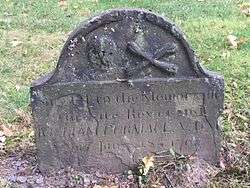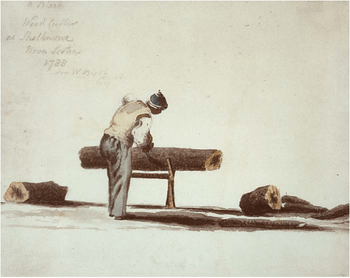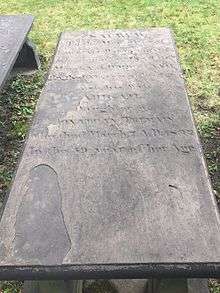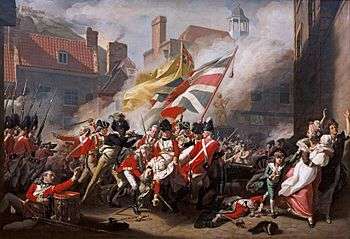Black Loyalist
| Black Loyalist | |
|---|---|
|
An unnamed, Black Loyalist, soldier, wearing a dark, wool, coat and feather cockade on his hat, with the British Army, during the American Revolutionary War, fighting in the 1781 Battle of Jersey, near England, in the English Channel, on the British-held, Channel Islands. The French, enemy forces, allied to the Patriot, military forces, of the American Thirteen Colonies, were eventually defeated, by the British, from the 1783 painting, "Death of Major Peirson", by artist, John Singleton Copley | |
| Active | 1775-1784 |
| Country |
|
| Allegiance |
|
| Branch | British provincial units, Loyalist militias, associators |
| Type | infantry, dragoons, (mounted infantry), irregular, labor duty |
| Size | companies-regiments |
| Engagements | American Revolutionary War |
| Commanders | |
| Notable commanders | white, British military officers and white, Loyalist unit officers, with a small number of black, Loyalist officers |
A Black Loyalist was a Loyalist inhabitant of British America, of African descent, who joined the British colonial, military forces, during the American Revolutionary War.[1] Many were slaves held by Patriot rebels who joined the British in exchange for The Crown's promises of freedom.
Some 3,000 Black Loyalists were evacuated from New York to Nova Scotia; they were individually listed in the Book of Negroes as the British gave them certificates of freedom and arranged for transport. The original of the Book of Negroes and an authenticated transcript are now online.[2] Some of the United Empire Loyalists who migrated to Nova Scotia brought enslaved African Americans with them, a total of 2,500 people. One historian has argued that the slaves were not regarded as Loyalists, since they had no choice in their fates.[3]
Thousands of black slaves escaped, from plantations, in the British colonies and the new United States, to British lines, especially after its occupation of Charleston, South Carolina. When the British evacuated, they took many former slaves with them. Some Black Loyalists were evacuated to London and were later included in the population of the Black Poor. With government assistance, 4,000 blacks were transported from London for resettlement to the colony of Sierra Leone in 1787. Five years later, another 1,192 Black Loyalists from Nova Scotia chose to migrate to Sierra Leone, as they were tired of the discrimination and climate in Canada. They became known in Sierra Leone as the Nova Scotian settlers and were part of creating a new nation and, ultimately, government. The modern-day Sierra Leone Creole people (Krios) are their descendants. The American leader Thomas Jefferson referred to the Black Loyalists as "the fugitives from these States".[4] Although many Black Loyalists gained freedom, many of them did not. Some black Loyalists escaped to the British northern colonies and states of the US and lived a life of freedom. Others left the US or escaped aboard British ships headed for Britain. The African slave Loyalists who were recaptured by Patriot slave traders were sold back into slavery and treated harshly for having served under the British and for trying to gain freedom in the first place.
Background
Slavery in England had never been authorized by legal statutes. Villeinage, a form of semi-serfdom, was legally recognised but long obsolete. In 1772, a slave threatened with being taken out of England and returned to the Caribbean challenged the authority of his master, in what became known as Somersett's case. Lord Mansfield, Chief Justice of the King's Bench, ruled that as slavery had no standing under common law, slave owners were unable to transport slaves outside England and Wales against their will. Many observers took it to mean that slavery was ended in England.
Lower courts often interpreted the ruling as determining that the status of slavery did not exist in England and Wales, but Mansfield had ruled more narrowly. The decision did not apply to the Thirteen Colonies and Caribbean colonies, where legislatures had passed laws to institutionalize slavery. A number of cases for emancipation of slave residing in England were presented to the English courts. Numerous runaways hoped to reach England, where they expected to gain freedom.
The slaves' belief that King George III was for them and against their masters rose as tensions increased before the American Revolution; colonial slaveholders feared a British-inspired slave revolt. In early 1775 Lord Dunmore wrote to Lord Dartmouth of his intent to take advantage of the situation.[5]
Proclamations
Lord Dunmore's Proclamation
In November 1775, Lord Dunmore issued a controversial proclamation, later known as Lord Dunmore's Proclamation. Faced with rebellion and short of troops, Virginia's royal governor called on all able-bodied men to assist him in the defense of the colony, including enslaved Africans belonging to rebels. He promised such slave recruits freedom in exchange for service in the British Army.
I do require every Person capable of bearing Arms, to resort to His MAJESTY'S STANDARD, or be looked upon as Traitors to His MAJESTY'S Crown and Government, and thereby become liable to the Penalty the Law inflicts upon such Offences; such as forfeiture of Life, confiscation of Lands, &c. &c. And I do hereby further declare all indented Servants, Negroes, or others, (appertaining to Rebels,) free that are able and willing to bear Arms, they joining His MAJESTY'S Troops as soon as may be, for the more speedily reducing this Colony to a proper Sense of their Duty, to His MAJESTY'S Crown and Dignity.--- Lord Dunmore's Proclamation, November 7, 1775[6]
Within a month, about 800 formerly enslaved African Americans had escaped to Norfolk, Virginia to enlist. It is likely that far more heard the call and would have joined if not for the fear of reprisal.[7][8]
Outraged Virginia slave owners decreed that runaway slaves would be executed. They also engaged in a smear campaign of the British Army's promises, saying that slaves who escaped to the British would be sold to sugar cane plantations in the West Indies. Still, many slaves were willing to risk their lives for a chance at freedom.[9]
Lord Dunmore's Proclamation was the first mass emancipation of enslaved people in United States history.[7] The 1776 Declaration of Independence refers obliquely to the Proclamation by citing as one of its grievances, that King George III had 'excited domestic Insurrections among us'.[10]
After the war began, a number of British generals issued proclamations calling for Loyalists to free their slaves so that they could join the undermanned British army and bolster its numbers. Among those issuing proclamations were John Murray, 4th Earl of Dunmore, Governor of Virginia,[7] and Sir Henry Clinton.[11] The Governor of Jamaica, John Dalling, drafted a proposal in 1779 for the enlistment of a regiment of mulattoes and a regiment of Negroes.[12]
The Philipsburg Proclamation
With the arrival of 30,000 Hessian troops, the need for Black soldiers greatly diminished. Sir William Howe banned the formation of new Black regiments and disbanded his own, but freeing slaves still held value as economic warfare against the rebels. In 1779, Sir Henry Clinton, as Commander-in-Chief of British forces in America, issued the Philipsburg Proclamation; he expanded Lord Dunmore's Proclamation and promised freedom to any escaped slave of a rebel.
The British often returned escaped slaves to Loyalist masters and requested the owner to refrain from punishment. In 1778, the Rebels promised freedom to escaped slaves of Loyalists. Most slaves who escaped to one side or the other ended up being sold back into slavery.[11] However, the British kept their promise; when they evacuated their troops from New York and Charleston, they took thousands of freed slaves with them. They resettled the freedmen in colonies in the Caribbean such as Jamaica, and in Nova Scotia in Canada, as well as transporting some to London. During the disruption of war, tens of thousands of slaves escaped to freedom, especially in southern colonies. Some died of both disease (the major cause of death among the troops) and warfare.
Black Loyalist military units
Lord Dunmore's proclamation, among others, led to the formation of several Black regiments in the British army. The most notable were Dunmore's Ethiopian Regiment and Clinton's Black Pioneers. Other regiments included the Jersey Shore Volunteers, the Jamaica Rangers, the Mosquito Shore Volunteers, and the Black Dragoons of the South Carolina Royalists. It was also, common for Black Loyalists to serve the military, in non-combat positions, such as the Black Company of Pioneers.[13][14]
Provincial corps
Black Company of Pioneers and Guides and Pioneers
The largest, Black Loyalist regiment was the Black Company of Pioneers, better known as the "Black Pioneers" and later merged into the Guides and Pioneers. In the military terminology of the day, a "pioneer" was a soldier who built roads, dug trenches, and did other manual labor. These soldiers were typically divided into smaller corps and attached to larger armies. While not a combat regiment, the Black Pioneers worked to build fortifications and other necessities. They could often be called upon to work under fire.[14] The Pioneers served under General Clinton in a support capacity in North Carolina, New York, Newport, Rhode Island, and Philadelphia. The Black Pioneers did not sustain any casualties because they were never used in combat. In Philadelphia, their general orders to "attend the scavangers, assist in cleaning the streets & removing all newsiances being thrown into the streets" [sic] made them essentially laborers, but they freed other soldiers for combat.[15]
Ethiopian Regiment
Lord Dunmore organized his 800 Black Loyalist volunteers, into the Ethiopian Regiment. The Ethiopians quickly trained in the rudiments of marching and shooting, before engaging in their first conflict, at the Battle of Kemp's Landing. The Patriot militia, at Kemp's Landing, was unprepared for the attack and quickly retreated. Next, Dunmore led the Royal Ethiopians, into the Battle of Great Bridge, but Dunmore was noe overconfident and he had been misinformed about the Rebel numbers. The Rebel forces overwhelmed the British troops. After the battle, Dunmore loaded his Black troops, onto ships, of the British fleet, hoping to take the opportunity, to train them better. The cramped conditions led to the spread of smallpox. By the time, Lord Dunmore retreated to the Province of New York, only 300, of the original 800 soldiers, had survived.[13]
Associators
Many, Black Loyalists were denied entry into regular, Loyalist units, because of racism or distrust by British and Loyalist officers. Others, joined the irregular associators also, known as Refugees, where they often served in interracial,|military units, where units, such as Brant's Volunteers were composed of 20% Loyalist Mohawks and 80% white, Loyalists.
Black Brigade
The "Black Brigade" was a small, "associators", combat unit, of twenty-four, elite, guerrillas, in New Jersey, led by Colonel Tye, a slave from Monmouth County who had escaped to British lines early in the war.[16] He was thought to be a veteran of Lord Dunmore's Ethiopian Regiment. The title of colonel was not an official military designation, as Blacks were not then formally commissioned as officers. However, such titles were permitted in an unofficial capacity, as in the case of Colonel Tye.
Tye and the Black Brigade were the most feared Loyalists in New Jersey, which was his home territory. He led them in several raids from 1778 at the Battle of Monmouth to defending the British in occupied New York in the winter of 1779. Beginning in June 1780, Tye led several actions against rebels in Monmouth County. In September 1780, Tye was wounded in the wrist during a raid on a rebel militia leader. Within weeks, he died from gangrene.[14] Former Black Pioneer leader, Stephen Blucke took over the Black Brigade and led it through the end of the war.[16]
Postwar treatment
When peace negotiations began after the Battle of Yorktown, a primary issue of debate was the fate of Black British soldiers. Loyalists who remained in the United States wanted Black soldiers returned so their chances of receiving reparations for damaged property would be increased, but British military leaders fully intended to keep the promise of freedom made to Black soldiers despite the anger of the Americans.[17]
In the chaos as the British evacuated Loyalist refugees, particularly from New York and Charleston, many American slave owners attempted to recapture their former slaves. Some would capture any Black, including those born free before the war, and sell them into slavery.[18] The US Congress ordered George Washington to retrieve any American property, including slaves, from the British, as stipulated by the Treaty of Paris (1783).
Since, Sir Guy Carleton intended to honour the promise of freedom, the British proposed a compromise that would compensate slave owners and provide certificates of freedom and the right to be evacuated to one of the British colonies to any Black person who could prove his service or status. The British transported more than 3,000 Black Loyalists to Nova Scotia, the greatest number of people of African descent to arrive there at any one time. One of their settlements, Birchtown, Nova Scotia was the largest free African community in North America for the first few years of its existence.[19]
Black Loyalists found the northern climate and frontier conditions in Nova Scotia difficult and were subject to discrimination by other Loyalist settlers, many of them slaveholders. In July 1784, Black Loyalists in Shelburne were targeted in the Shelburne Riots, the first recorded race riots in Canadian history. The Crown officials granted land to the Black Loyalists of lesser quality and that were more rocky and less fertile than that given to White Loyalists. In 1792, the British government offered Black Loyalists the chance to resettle in a new colony in Sierra Leone,. The Sierra Leone Company was established to manage its development. Half of the Black Loyalists in Nova Scotia, nearly 1200, departed the country and moved permanently to Sierra Leone. They set up the community of "Freetown".[20]
In 1793, the British transported another 3,000 Blacks to Florida, Nova Scotia and England as free men and women.[21] Their names were recorded in the Book of Negroes by General Carleton.[22][23]
Not all were so lucky. In the South, blacks were seen as easy targets, and planters often ignored their claims of freedom. Many British officers and Loyalists considered them to be spoils of war. When Britain ceded Florida to Spain, many of the freedmen, who had been transported there from the United States, were left behind when the British pulled out.[24] However, the Spanish both offered freedom and the right to bear arms to blacks who would convert to Catholicism and encouraged slaves to escape to Florida.
Descendants
Many descendants of Black loyalists have been able to track their ancestry by using General Carleton's Book of Negroes.[25]
Nova Scotia

Between 1776 and 1785, around 3,500 Blacks were transported to Nova Scotia from the United States, part of a larger migration of about 34,000 Loyalist refugees. This massive influx of people increased the population by almost 60%, and led to the establishment of New Brunswick as its own colony in 1784. Most of the free Blacks settled at Birchtown, the largest Black township in North America at the time, next to the town of Shelburne, settled by whites.[28]

Among, the descendants of the Black Loyalists are noted figures such as Rose Fortune, a Black woman living in Nova Scotia who became a police officer and a businesswoman.[29] Measha Brueggergosman (née Gosman), the Canadian opera and concert singer, is a New Brunswick native and descendant of a Black Loyalist through her father. In the closing days of the Revolution, along with British troops and other Black Loyalists, her paternal four-times-great-grandfather and grandmother left the colonies. They were resettled in Shelburne with their first child, who had been born free behind British lines in New York.
Commemoration
The Black Loyalist settlement of Birchtown, Nova Scotia was declared a National Historic Site in 1997. A seasonal museum commemorating the Black Loyalists was opened in that year by the Black Loyalist Heritage Society. A memorial has been established at the Black Loyalist Burying Ground. Built around the historic Birchtown school and church, the museum was badly damaged by an arson attack in 2008 but rebuilt. The Society began plans for a major expansion of the museum to tell the story of the Black Loyalists in America, Nova Scotia and Sierra Leone.[30]
Sierra Leone

Some Black Loyalists were transported to London, where they struggled to create new lives. Sympathy for the black veterans who had fought for the British stimulated support for the Committee for the Relief of the Black Poor. This organization backed the resettlement of the black poor from London to a new British colony of Sierra Leone in West Africa. In addition, Black Loyalists in Nova Scotia were offered the opportunity to relocate, and about half chose to move to the new colony. Today the descendants of these pioneers are known as the Sierra Leone Creole people, or Krios. They live primarily in the Western Area of Freetown.
Black Loyalists from the American South brought their languages to Freetown, such as Gullah from the Low Country and African American Vernacular English. Their lingua franca was a strong influence on the descendants of this community, who developed Krio as a language. Many of the Sierra Leone Creoles or Krios can trace their ancestry directly to their Black Loyalist ancestors.
An example of such an ancestor is Henry Washington, likely born about 1740 in The Gambia, enslaved as a young man and shipped to Virginia.[33] He was purchased by George Washington in 1763; he escaped about 1776 in Virginia to British lines, eventually making his way to New York.[34] He was among free blacks evacuated to Nova Scotia by the British following the war.[34][35] He later took the opportunity to migrate to Freetown in Africa. There by 1800 he became the leader of a rebellion against colonial rule and faced a military tribunal.[33] His descendants are part of the Creole population, who make up 5.8% of the total.
Notable Black Loyalists
- William Flora
- David George
- Abraham Hazeley
- Boston King
- John Kizell
- John Marrant
- Cato Perkins
- Thomas Peters
- Colonel Tye
- Henry Washington
In popular culture
- The saga of the Black Loyalists inspired Lawrence Hill's 2007 novel The Book of Negroes (published as Someone Knows My Name in the United States). It won the 2008 Commonwealth Award for Fiction.
See also
References
- ↑ Cassandra Pybus, Epic Journeys of Freedom: Runaway Slaves of the American Revolution and Their Global Quest for Liberty, (Beacon Press, Boston, 2006); Graham Russell Hodges, Susan Hawkes Cook, Alan Edward Brown (eds), The Black Loyalist Directory: African Americans in Exile After the American Revolution (subscription required)
- ↑ The Book of Negroes, Black Loyalists.
- ↑ The Black Loyalist Myth in Atlantic Canada by Barry Cahill
- ↑ Jefferson, Thomas (1900). The Jeffersonian Cyclopedia. p. 621 (#5808). Retrieved August 6, 2010.
- ↑ Selig, Robert A. "The Revolution's Black Soldiers". AmericanRevolution.org. Retrieved 2007-10-18.
- ↑ "Lord Dunmore's Proclamation". Digital History. 2007-10-18. Archived from the original on 2008-04-22. Retrieved 2007-10-18.
- 1 2 3 "Lord Dunmore's Proclamation". Black Loyalists: Our History, Our People. Canada's Digital Collection. Retrieved 2007-10-17.
- ↑ Jack Phillip Greene, Jack Richon Pole (2000). A Companion to the American Revolution. Blackwell Publishing. p. 241. ISBN 0-631-21058-X. Retrieved 2007-10-18.
- ↑ "Escape from Slavery". Black Loyalists: Our History, Our People. Canada's Digital Collection. Retrieved 2007-10-17.
- ↑ Kaplan, Sidney (July 1976). "The "Domestic Insurrections" of the Declaration of Independence". Journal of Negro History (PDF). 61 (3): 243–255. doi:10.2307/2717252. JSTOR 00222992.
- 1 2 "The Philipsburg Proclamation". Black Loyalists: Our History, Our People. Canada's Digital Collection. Retrieved 2007-10-17.
- ↑ Dalling, John (May 25, 1779). "Black Loyalists Proposed Corps". Loyalist Institute. Retrieved 2007-10-18.
- 1 2 "The Royal Ethiopian". Black Loyalists: Our History, Our People. Canada's Digital Collection. Retrieved 2007-10-17.
- 1 2 3 "The Black Pioneers". Black Loyalists:Our History, Our People. Canada's Digital Collection. Archived from the original on 2007-09-28. Retrieved 2007-10-18.
- ↑ Nan Cole and Todd Braisted (February 2, 2001). "A History of the Black Pioneers". Loyalist Institute.
- 1 2 Jonathan D. Sutherland, African Americans at War, ABC-CLIO, 2003, pp. 420-421, accessed 4 May 2010
- ↑ "The Treaty of Paris". Black Loyalists: Our People, Our History. Canada's Digital Collections. Retrieved 2007-10-18.
- ↑ "Chaos in New York". Black Loyalists: Our People, Our History. Canada's Digital Collections. Archived from the original on 2007-11-17. Retrieved 2007-10-18.
- ↑ "Who were the Black Loyalists?". Remembering Black Loyalists, Black Communities in Nova Scotia. Nova Scotia Museum. Retrieved 2007-10-18.
- ↑ Ferguson, William Stenner. Why I Hate Canadians, 1997.
- ↑ Among them was Deborah Squash, a 20-year-old woman who had escaped from George Washington's plantation in 1779. She is described in the Book of Negroes as a "stout wench, thick lips, pock marked. Formerly slave to General Washington, came away about 4 years ago." "Life Stories: Profiles of Black New Yorkers During Slavery and Emancipation" (PDF). Slavery in New York. New-York Historical Society. 2005. p. 103. Retrieved 2007-10-19."Book of Negroes". Black Loyalists: Our People, Our History. Canada's Digital Collections. 1783. Retrieved 2007-10-19.
- ↑ "Certificates of Freedom". Black Loyalists: Our People, Our History. Canada's Digital Collections. Retrieved 2007-10-18.
- ↑ "The Book of Negroes". Africans in America: Revolution. PBS. Retrieved 2007-10-19.
- ↑ "Returned to Slavery". Black Loyalists: Our People, Our History. Canada's Digital Collections. Retrieved 2007-10-18.
- ↑ Sege, Irene (February 21, 2007). "The search:Interest in piecing together family trees grows among African-Americans". The Boston Globe. Retrieved 2007-10-18.
- ↑ Jack C. Whytock. The Huntingdonian Missionaries to Nova Scotia and New Brunswick, c. 1785-1792
- ↑ Jack C. Whytock. Historical Papers 2003: Canadian Society of Church History. Edited by Bruce L. Guenther, p.154.
- ↑ "Black Loyalist Communities in Nova Scotia". Remembering Black Loyalists, Black Communities in Nova Scotia. Nova Scotia Museum. Retrieved 2007-10-18.
- ↑ "Rose Fortune, a special Canadian!". African American Registry. 2005. Archived from the original on 2007-09-30. Retrieved 2007-10-18.
- ↑ Black Loyalist Heritage Society website
- ↑ Canadian Biography Also see Hartshorne's portrait by Robert Field (painter)
- ↑ Find a Grave
- 1 2 Cassandra Pybus, “Washington’s Revolution (Harry, that is, not George)”, Atlantic Studies, Vol. 3, No. 2, 2006, 183-198
- 1 2 Lepore, Jill (8 May 2006). "Goodbye, Columbus: When America won its independence, what became of the slaves who fled for theirs?". The New Yorker. Retrieved 8 March 2015.
- ↑ Black Loyalist website.
- Cassandra Pybus, Epic Journeys of Freedom: Runaway Slaves of the American Revolution and Their Global Quest for Liberty, New York: Beacon, 2006
- Simon Schama, Rough Crossings: Britain, the Slaves, and the American Revolution (London: BBC Books, 2005) (New York: Ecco, 2006 )
- James Holman, Travels in Madeira, Sierra Leone, Teneriffe, St. Jago, Cape Coast, Fernando Po, Princes island, etc. (Google eBook), 1840
External links
- Black Loyalist website
- "Biographies of the Loyalist Era: Thomas Peters, Black Loyalist", The Loyalists, Learn Quebec
- "Loyalties", University of Manitoba, Vol. 17, No. 1
- Heritage: Black Loyalists, Saint John
- Black Loyalist Heritage Society, official website
- Black History, National Archives, United Kingdom
- Africans in America: Revolution, PBS
- Loyalist Institute, Documents and writings on Black Loyalists
- Anti-Slavery movement, Collections Canada
- Enslaved Africans in Upper Canada, Archives
- Nova Scotia archives, virtual exhibition
- Black Loyalists' experience in Canada, Atlantic Canadian Portal
